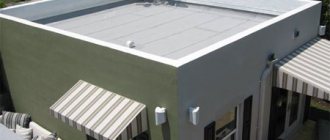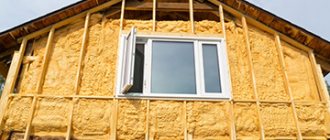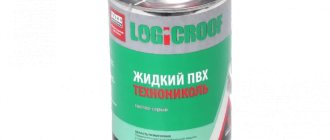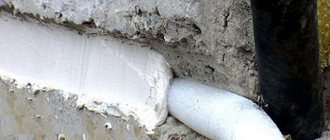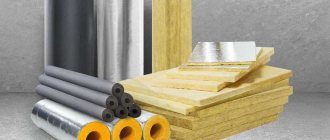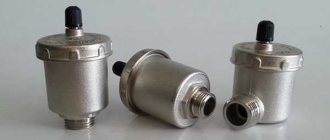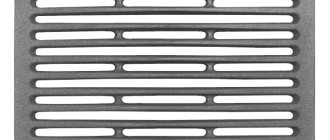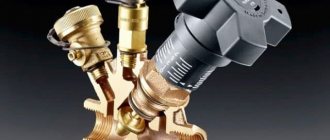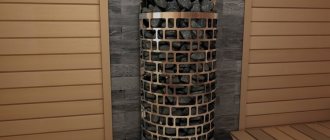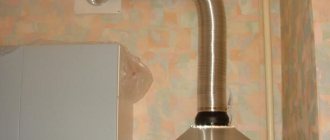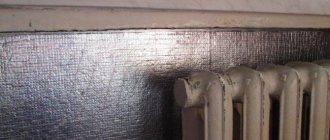Calculation of insulation thickness
Many people mistakenly believe that the thickness of the insulation is a constant value and is, for example, 100 mm, which in turn is a misconception. From an engineering point of view, the thickness of the insulation layer is a calculated value and depends on the region of construction, the design of the building walls, the type of material, the number of cold days per year, and many other factors.
To determine the thickness, it is necessary to perform a thermal calculation in accordance with the requirements of SP 50.13330.2012 “Thermal protection of buildings” . Competent engineering calculations will save a lot of money and at the same time achieve maximum results.
A set of measures to reduce heat loss:
- Energy-saving ventilation device;
- Roofs;
- Facade and slopes of openings;
- Installation of energy-saving windows and doors;
- Heated floor installation.
Calculation of the thickness of materials for facade insulation
The thickness of the insulation material is determined individually in each specific case of facade insulation. To determine this, without exaggeration, the most important parameter, you will need to know:
- thermal conductivity indicators of all materials that make up the load-bearing wall;
- the thickness of each layer of the load-bearing wall;
- climatic coefficient of minimum thermal resistance.
The thermal resistance of an external wall is the total resistance of all the materials of which it is composed.
- To calculate the climate indicator, the difference between the indoor temperature and the average external temperature during the heating period is used.
- To find the thermal resistance of insulation, you need to calculate the total coefficient of all wall materials and subtract the resulting amount from the average for your region.
- The thickness of the insulation is determined as the product of its thermal resistance and thermal conductivity coefficient.
A complete, accurate and professional calculation of the thickness of the insulating layer can be obtained by contacting a company engaged in facade work. For example, right now on our website you can order a free estimate for upcoming work, including the quantity and cost of the necessary materials.
Visit of a specialist and preparation of an estimate - free of charge
Order an estimate
Dew point shift diagram
There are several options for placing insulation relative to the wall: inside, outside, between walls. The main thing to start from is the dew point. Let's look at all the options.
The dew point is the temperature at which water vapor in the air reaches saturation and begins to condense. The dew point at 100% air humidity and the actual air temperature are the same.
Based on current trends, insulating the exterior of a house’s facade is the best option for preserving heat. In this case, the dew point falls on the insulation, which means there will be dry walls inside. Otherwise, the wall outside will freeze, and the inside of the house will become wet and moldy. This process is shown more clearly in the figure above.
Features of insulation
The comfort of the premises depends on the insulated side of the thermal insulation , its type and thickness. Facade insulation systems for buildings create the most comfortable temperature conditions in the house and prevent the appearance of condensation.
Calculation of material thickness
To calculate the thickness of the insulating material, an insulating specialist first studies the characteristics of the building - the type of structure, the material of the load-bearing walls. After careful analysis, the most suitable thickness is selected.
What is the optimal insulation density?
to choose insulation of optimal thickness, taking into account the type of wall material and wall thickness. For example, for a frame house where the wall thickness is 15 cm, it is best to use basalt wool with a density of 50 kg/m3. New technologies allow you to save heat in your home at an affordable price.
Approximate prices for insulation per 1m2
The price for facade work depends on the material used and the region where the work is carried out. Russia is located in climatic zones where heating plays an important role.
Estimated costs of services:
- facade priming from 50 rub./m2;
- insulation of the facade and basement - excluding building materials from 400 rubles/m2;
- Turnkey facade insulation – from 2000 rubles per 1 m2.
Internal
This method has a number of significant disadvantages. It should be resorted to only if it is not possible to implement an external method.
Flaws:
- Reducing the usable volume of the room.
- Cold bridges in places where interfloor ceilings adjoin (to eliminate them, treatment of floors and ceilings is required).
- Premature destruction of walls due to condensation of moisture in them and their freezing at negative outdoor temperatures.
- Additionally, the organization of good ventilation of the premises;
Advantages:
- ability to work in any weather
- easy access to walls without the use of industrial climbers, construction scaffolding, or façade lifts.
Important!
In order to prevent the formation of mold and mildew on the inner surface of the walls, deterioration of the indoor microclimate, and also to avoid dampness in the house, it is necessary to use heat-insulating materials with a low vapor permeability coefficient:— expanded polystyrene with a density of 35 kg/m3 and higher (the denser the better);
— extruded polystyrene foam;
— polyurethane foam with closed cells.
Important!
It is unacceptable to insulate walls from the inside with mineral wool. This material has higher vapor permeability than concrete, brick, block walls, and also has a high water absorption value.All this leads to the accumulation of mineral wool moisture and deterioration of its thermal insulation properties, the appearance of harmful microorganisms, dampness and unpleasant odor in the room, and premature destruction of thermal insulation.
How to insulate the outside of a house with your own hands using penoplex and polystyrene foam
Thermal insulation boards of polystyrene foam and penoplex are used mainly for insulating brick, block and concrete walls of houses. When the surface of the outer wall is prepared, they begin to insulate the house from the blocks from the outside. If foam plastic is used as an insulating material, it is very important to thoroughly dry the walls, otherwise the material may become saturated with moisture and lose its thermal insulating properties. This nuance especially needs to be taken into account before insulating a block house from the outside.
The finishing strip serves as a support for the bottom row of insulation boards.
How to insulate a house made of foam blocks from the outside with foam plastic for subsequent finishing with decorative plaster? Sheets of foam plastic or penoplex are attached to the wall using a special adhesive. In order to glue the first row of slabs evenly, it is recommended to fasten the finishing strip along the bottom edge of the wall. After applying the glue, the sheets are pressed against the wall with little force. You can additionally fix the sheets using mushroom dowels in the center and corners of the sheet. Using a level and plumb lines, the plane of the applied foam layer is controlled.
As soon as the first layer has set well, begin installing the next one. It is recommended to offset the sheets of the second layer of foam relative to the rows of the first layer. This will allow the dowels to hold the middle of the sheets of the previous layer of foam.
For greater strength, the structure of insulation boards is attached to the wall using mushroom dowels, and the seams are taped with reinforcing tape.
In places where windows and wall corners are located, a frame is installed from a corner to which the insulation is attached.
The joining seams are sealed with reinforcing tape. As soon as the insulation is applied to all walls, the surface is reinforced with a plaster mesh. Next, the surface is treated with a primer and plastered. Care must be taken to ensure that there are no cracks or gaps through which the insulation can be seen. Helpful advice! Helpful advice!
If penoplex is used as insulation, the surface of the slabs is treated with a needle roller before installation to give them a rough structure. This is necessary for better adhesion of the penoplex to the surface of the walls. Sometimes they use the method of insulating walls with foam plastic using wooden slats. This installation of insulation allows the use of slatted lathing for covering walls with finishing materials (lining, siding).
For high-quality cladding of external walls, the insulation layer must be laid as evenly as possible.
How to insulate a house made of foam block from the outside using slats? First, the frame is made. The width of the slats for the frame should be greater than the thickness of the thermal insulation material - then a cavity for ventilation will be formed between the foam plastic and the cladding material. The distance between the frame slats should be slightly less than the width of the inserted sheet of insulation, so that it is held tightly between them by a spacer.
For subsequent application of decorative plaster, the insulation layer is reinforced with fiberglass mesh.
Learn the advice of professionals on the best way to insulate a brick house from the outside.
On the Internet you can watch the video “How to insulate a house from the outside with polystyrene foam with your own hands.”
Choice of insulation
Mineral wool
Mineral wool is an insulating material that consists of inorganic fibers of natural or synthetic origin. Stone (basalt) wool is used in ventilated facades.
Experts mainly use mineral wool when constructing a suspended ventilated facade, as well as when insulating multi-storey buildings using wet facade technology due to the resistance of mineral wool to mechanical stress and its non-flammability (flammability group NG according to GOST 30244-94).
Due to the high values of vapor permeability and moisture saturation, this material cannot be used in foundations, plinths, internal walls and other areas subject to regular exposure to moisture.
Expanded polystyrene
Due to its relatively low cost and high thermal insulation properties, expanded polystyrene (foam) has been widely used in our organization when constructing wet facades of low-rise buildings. It is also often used for internal and inter-wall insulation of walls, and for the production of facade decorative elements.
Flammability group G1 according to GOST 30244-94. When insulating a house with polystyrene foam, to ensure fire protection of the building, it is necessary to take a number of measures:
- along the perimeter of window and door openings, make edgings made of non-combustible mineral wool slabs with a width of at least 150 mm;
- install fireproof cutouts made of non-combustible mineral wool slabs at the level of the upper slopes of openings along the entire length of the building façade, on each floor, but at least 4 m in height, with a width of at least 150 mm.
Expanded polystyrene is a fragile material. Due to low compressive and bending strength, it is not used in areas subject to mechanical loads. We also do not recommend using polystyrene foam in foundations and basements. Despite the low moisture saturation rates, the material still has technological pores and is hygroscopic.
Extruded polystyrene foam
Extruded polystyrene foam (EPS), like polystyrene foam, is made from polystyrene, but using a completely different technology.
As a result, the technical characteristics of EPS are significantly better compared to polystyrene foam:
- the moisture saturation rate is 10 times lower (0.4% versus 4% when in water for 30 days);
- thermal conductivity is 15% lower (0.031 W/(m*K) versus 0.036 W/(m*K);
- bending resistance and compressive strength are 5 times higher;
- vapor permeability is 3 times lower (0.015 mg/(m*h*Pa) versus 0.05 mg/(m*h*Pa);
- practically does not shrink;
- the flammability class is the same (G1 according to GOST 30244-94).
Expanded polystyrene does not allow steam to pass through, so in ventilated facades it is used only for insulating basement floors. It is also used for insulating plaster facades.
Polyurethane foam
Polyurethane foam (PPU) is a heat-insulating material that is applied by spraying.
Depending on the density, there are soft polyurethane foam (density 8-20 kg/m3) and hard polyurethane foam (density 45-60 kg/m3).
Soft polyurethane foam is elastic and has an open-cell structure. In terms of thermal conductivity, vapor permeability and moisture saturation, it is comparable to mineral wool. Due to its high cost, low mechanical resistance and high hygroscopicity, this material is practically not used in the construction industry.
Rigid polyurethane foam has a closed-cell structure, is currently the most advanced material and has the following advantages:
- has the lowest thermal conductivity among competitors (0.020-0.028 W/(m*K);
- is a good waterproofing material due to its low hygroscopicity;
- good adhesion to concrete, metal, brick, wood, plasterboard surfaces;
- absence of seams, joints, cold bridges
- high rate of thermal insulation work;
- easy to apply on surfaces of complex geometric shapes;
- term
Among the disadvantages it should be noted:
- expensive application equipment;
- highly qualified operator is required;
- high cost (turnkey price for spraying a layer 50 mm thick starts from 1,100 rubles/m2).
Flammability group G1 according to GOST 30244-94.
Mineral wool insulation technique
You have to be careful when working with mineral wool. To prevent the material from accumulating moisture, it is recommended that each mat be placed in plastic bags, the integrity of which should not be compromised. In practice, it's simpler. Lay a layer of film or a special polymer membrane on the wall, and protect the insulation layer from the outside in the same way.
Mats can be fastened with anchors and umbrella dowels. Installation directly on the wall is allowed and quite convenient if expensive, dense and rigid basalt insulation is used for the facade. But in practice, it is more rational to lay thermal insulation elements in a sheathing made of wooden slats or a special profile.
Laying mineral wool mats into lathing is another convenient way to insulate wooden houses. This step also allows you to create a beautiful and high-quality exterior finish.
The outer layer of the insulation structure when using mineral wool can be varied and is created from decorative panels, siding, lining and other materials.
It will be important for you
Warranty – from 3 years!
Photo reports from the place
Free estimate
We resolve issues promptly
Cleaning up after ourselves
We meet deadlines
SRO approval, certificate of conformity GOST R ISO 9001-2015:
Price list
Turnkey ventilated facade
| Name | Without insulation | 50mm | 100mm |
| — Profiled sheet, rub/m2 | 2215 | 2500 | 2610 |
| — Metal siding, rub/m2 | 2715 | 3000 | 3110 |
| — Porcelain tiles, rub/m2 | 3045 | 3330 | 3440 |
| — Fiber cement panels, rub/m2 | 3175 | 3460 | 3570 |
| — Metal cassettes, rub/m2 | 3415 | 3700 | 3810 |
| — Composite cassettes, rub/m2 | 3520 | 3805 | 3915 |
| — Planken, rub/m2 | 4815 | 5100 | 5210 |
| — Clinker tiles, rub/m2 | 5245 | 5530 | 5640 |
| — Aluminum cassettes, rub/m2 | 5440 | 5725 | 6835 |
| — Natural stone, rub/m2 | 6090 | 6375 | 6485 |
| — HPL panels, rub/m2 | 6860 | 7145 | 7255 |
| — Terracotta panels, rub/m2 | 7815 | 8100 | 8210 |
| — Lamellas, rub/m2 | 9215 | 9500 | 9610 |
| Name / thickness of thermal insulation | 60mm | 80mm | 100mm |
| Turnkey installation of thermal panels lined with artificial stone, rub/m2 | 3300 | 3450 | 3550 |
*Processing the seams of a panel house using warm seam technology – 300 rubles/m.m.
Cladding with thermal panels
| Name | Price |
| Thermal calculation | For free |
| Installation/dismantling of frame scaffolding | 120 rub/m2 |
| Leveling plaster (with a difference of more than 30 mm) | 520 rub/m2 |
| Frame structure (with a difference of more than 30 mm) | 300 rub/m2 |
| Fastening thermal panels | 800 rub/m2 |
| Grouting joints | 300 rub/m2 |
| Construction of slopes, running meters: | |
| Plastering | 650 rub/m. |
| Steel | 350 rub/m. |
| From clinker tiles | 800 rub/m. |
| Installation of ebb tides | 350 rub/m. |
| Installation of spotlights | 600 rub/m. |
| Attaching the end strip | 350 rub/m. |
| Installation of a drainage system | 350 rub/m. |
Guidelines for thermal insulation of facades
Reading time: 4 minute(s) The main purpose of thermal insulation is to create a reliable energy-saving barrier that ensures minimal heat loss during the cold season and creates a comfortable temperature for living with minimal energy consumption. Read the instructions for insulating facades with mineral wool on this page.
The picture shows the process of installing thermal insulation on a façade
Features of facade thermal insulation
Experts recommend insulating facades from the outside, since thermal insulation of facades from the inside will eventually lead to the formation of condensation and, as a result, waterlogging of the insulation and the creation of favorable conditions for the development of mold and fungi. In addition, the use of external thermal insulation of building facades will protect the wall from the effects of precipitation and other external factors, and this, accordingly, will significantly extend the life of capital structures. Read what materials are used for facade insulation and a description of popular technologies.
Thermal insulation systems for building facades
For thermal insulation of facades under plaster, the most suitable insulation materials are mineral wool and polystyrene foam.
- Thermal insulation of facades under plaster is recommended to be carried out at air temperatures from +15°C to +25°C;
- The wall must be cleaned, leveled and primed;
- Then the insulation is glued.
- The insulation must be reinforced with a special fiberglass mesh.
- Then the walls are covered with decorative plaster or paintable plaster.
- After installing the thermal insulation boards, reinforcement is carried out with galvanized steel mesh.
- Completes the entire protective and decorative coating.
The technology of thermal insulation of facades under plaster is characterized by double fastening of the insulation: with glue and with dowels.
If the thermal insulation system uses a thick layer of plaster, the insulation is secured using reinforcing steel mesh and anchors. When installing this system, the requirements for the evenness of the working base and the density of the insulation are minimal. Thermal insulation can be carried out at low temperatures, since the insulation is attached only mechanically, without the use of adhesive solutions.
To prevent cracks from appearing in the plaster layer during the operation of the building, it is necessary to prepare temperature-shrinkage joints.
Liquid thermal insulation "Akterm Facade" is suitable for covering walls made of any building material.
Thermal insulation work is recommended to be carried out at air temperatures from +7°C to +45°C. “Akterm” is applied like ordinary paint, using rollers and brushes. The use of Akterm liquid insulation helps prevent the occurrence of corrosion, the development of mold and mildew; makes it possible to thermally insulate hard-to-reach places; does not create additional load on load-bearing walls.
Akterm liquid thermal insulation can be used as a finishing façade coating. The guaranteed service life of liquid thermal insulation is at least 15 years.
Installing a ventilated façade will keep the insulation and walls dry thanks to natural ventilation. Installation work can be carried out at any time of the year. A steel or aluminum frame is attached to the wall, insulation (basalt wool) is placed in the space between the slats and secured with dowels. A sheathing is mounted on top of the insulation so that there is a free space of 3-5 cm between the cladding and the insulation for the passage of natural air flow, which dries out the insulation layer when it is moistened. Wall cladding can be very diverse.
The process of thermal insulation of a facade with foam plastic begins with preparing the surface of the walls (cleaning of old coating and dirt, then priming). The insulation can be fixed to the wall in two ways: with an adhesive base and with dowels; for reliability, you can combine these two methods. When gluing, the bottom row of insulation should rest on the starting profile, previously fixed along the perimeter of the base.
To increase the mechanical strength of the insulation, all corners of the house, as well as the corners of the slopes of doors and windows, are strengthened using a perforated corner, the remaining surface of the foam is glued with a reinforcing mesh with an overlap of 5-10 cm.
Insulation of the facade of the house with polystyrene foam ends with decorative finishing, no earlier than two days after installation of the reinforcing mesh.
When applying liquid thermal insulation Corundum, the treated surface can be made of any material, since Corundum Facade is characterized by excellent adhesion (adhesion to the surface of the material), and can also have any shape and location. To carry out thermal insulation work, the surface must be cleaned of dust and rust, and also have a temperature from +7°C to +150°C. Easy-to-use liquid thermal insulation does not require special skills and can be applied like regular paint. Thermal insulation Corundum Facade additionally contains additives that increase the resistance of the material to fading when exposed to sunlight. Various façade coatings can be applied on top of the thermal insulation layer. Read a review of types of insulation for siding here: https://frontfacade.com/uteplenie/rukovodstvo-po-utepleniyu-doma-snaruzhi-pod-sajding.html.
There are two ways to insulate the facade of a house using polyurethane foam: using sheet polyurethane foam, manufactured in the form of rigid monolithic slabs, and using the polyurethane foam spraying method.
The technology of thermal insulation of the facade with sheet polyurethane foam is carried out similarly to other thermal insulation materials. The outer surface of the wall is cleaned, and sheet polyurethane foam is tightly attached to the adhesive base. The seams can be sealed with polyurethane foam. Ultraviolet radiation has a destructive effect on polyurethane foam, so it is recommended to carry out decorative and protective finishing of the facade.
The polyurethane foam spraying method is most in demand, since during installation it requires minimal physical and financial costs.
The surface of the wall is also cleaned, and then polyurethane foam is applied to it by spraying (a solid layer of thermal insulation is formed). Installation of additional insulating layers and fasteners is not required. As a protective and decorative layer, you can use various types of siding or facade paint and plaster.
External thermal insulation systems for facades
External thermal insulation systems are the most effective solution to the problem of heat conservation in a building. In the construction of public buildings, thermal insulation of ventilated facades is most common, and in residential construction, thermal insulation of facades under plaster is most often used. It is not so common today to use thermal insulation of facades with sprayed polyurethane foam, but the use of polyurethane foam methods will allow you to obtain environmentally friendly and hypoallergenic thermal insulation that does not emit toxic fumes. The main factor influencing the quality technological characteristics of systems is compliance with the technology of its installation.
Price for thermal insulation of facades
Insulation of the facade with heat-insulating panels along the frame - from 1000 rubles/m2; Spraying of polyurethane foam – from 600 rub./m2 to 800 rub./m2; Liquid thermal insulation – from 150 rub./m2 to 300 rub./m2; Thermal insulation for plaster – 770 rub./m2; Thermal insulation of ventilated facades: foam plastic 1800 rub./m2, basalt slabs 2310 rub./m2.
Where to buy materials for thermal insulation of facades?
The photo shows the process of installing thermal insulation on the facade of a house in Moscow:
- , Sharikopodshipnikovskaya street, 13 from 62. tel.;
- , 6th Radialnaya st., 62, building 1. office no. 9. tel.;
- , Marshala Zhukov Ave., building 2, building 1. tel.: +7 (499) 372-12-40.
In St. Petersburg:
- LLC "NTM Stroy", st. Furniture, building 12 building 1. tel.: +7 (812) 948-45-66;
- LLC "Trading house "Elite House", st. Sedova, 13, office. 423. tel.;
- IC "Ferotex", Irinovsky prospect, building 1, office 320. tel.: + 7 (812) 611-12-12.
Video
Watch video recommendations for thermal insulation of facades:
You can choose any facade thermal insulation system that is most suitable for you - both in terms of financial and aesthetic parameters, and with qualified installation it will be quite effective. Read about facade restoration technologies on this page.
Did this article help you? We would be grateful for your rating:
1 0

